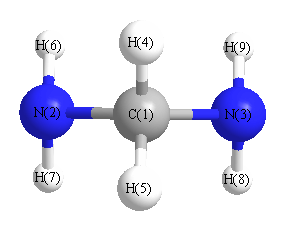Vibrational Frequencies calculated at QCISD(T)/aug-cc-pVDZ
| Mode Number |
Symmetry |
Frequency
(cm-1) |
Scaled Frequency
(cm-1) |
IR Intensities
(km mol-1) |
Raman Act
(Å4/u) |
Dep P |
Dep U |
|---|
| 1 |
A1 |
3450 |
3374 |
|
|
|
|
| 2 |
A1 |
3050 |
2982 |
|
|
|
|
| 3 |
A1 |
1647 |
1610 |
|
|
|
|
| 4 |
A1 |
1473 |
1441 |
|
|
|
|
| 5 |
A1 |
1093 |
1069 |
|
|
|
|
| 6 |
A1 |
852 |
833 |
|
|
|
|
| 7 |
A1 |
445 |
435 |
|
|
|
|
| 8 |
A2 |
3542 |
3464 |
|
|
|
|
| 9 |
A2 |
1384 |
1353 |
|
|
|
|
| 10 |
A2 |
1063 |
1040 |
|
|
|
|
| 11 |
A2 |
248 |
243 |
|
|
|
|
| 12 |
B1 |
3541 |
3462 |
|
|
|
|
| 13 |
B1 |
3098 |
3029 |
|
|
|
|
| 14 |
B1 |
1359 |
1329 |
|
|
|
|
| 15 |
B1 |
842 |
824 |
|
|
|
|
| 16 |
B1 |
371 |
363 |
|
|
|
|
| 17 |
B2 |
3451 |
3374 |
|
|
|
|
| 18 |
B2 |
1639 |
1603 |
|
|
|
|
| 19 |
B2 |
1373 |
1342 |
|
|
|
|
| 20 |
B2 |
1085 |
1061 |
|
|
|
|
| 21 |
B2 |
803 |
786 |
|
|
|
|
Unscaled Zero Point Vibrational Energy (zpe) 17905.1 cm
-1
Scaled (by 0.9778) Zero Point Vibrational Energy (zpe) 17507.6 cm
-1
See section
III.C.1 List or set vibrational scaling factors
to change the scale factors used here.
See section
III.C.2
Calculate a vibrational scaling factor for a given set of molecules
to determine the least squares best scaling factor.
